Another loaf, another flat disc. I just cannot seem to get a handle on sourdough bread. I have been meticulously maintaining my starter for two months now, never skipped a single feeding, never let it get stagnant, always calculate to the gram, always careful of its temperature, always making sure the filtered water is at the correct temp etc etc... it just does not want to leaven my bread.
The starter is sluggish, and its behaviour is unpredictable. Some days, it'll triple in size in 6-8 hours, other days it doesn't respond much to a feeding at all. I have tried 1:5:5, 1:2:2, 1:1:1 ... I have tried Five Roses never bleached AP, Robbin Hood Bread flour, have tried adding 50% WW from Bulk Barn, nothing seems to really change its behaviour. It smells yeasty with a hint of yoghurt, so I know there is yeast activity. It just doesn't seem to build up past a certain point. I try to always feed it after it has peaked and starting to cave.
I tried baking another loaf yesterday / today, and it turned out pretty flat like usual. The dough came together not too bad, the stretch and folds felt great, I could feel the strength building nicely, then it started to feel slack after bulking for 3-4 hours. When I tried to pre-shape the dough, it felt so much wetter and way stickier than when I had started. Shaping was a disaster. I almost binned it. I then composed myself and added a mountain of flour all around it and managed to "shape" it and put it in a Banneton. It grew considerably in the Banneton for 2 hours. Then it went into the fridge over night. It grew in the fridge even more. I was surprised. Baked it this morning and there is basically no oven spring to speak of. Crumb looks good, flavour is great. Balanced acidity.
Recipe: 60% hydration
450g Bread Flour (12.3-13.3%)
50g whole wheat
300g water
100g mature starter (100% hydration)
10g salt
Mix flour, water and starter until combined, autolyse 30 minutes
Add salt, mix in standing mixer on low for 2-3 minutes
Knead in standing mixer at medium approximately 5-6 minutes
Transfer to bowl and rest 30 minutes
Stretch and fold, rest 60 minutes
Stretch and fold, rest another 30-45 minutes
Stretch and fold, tuck edges underneath to form ball shape
Bulk 2-3 hours until 20-30% larger
Preshape on counter (this is where it really wasn't working anymore)
Shape and transfer to proofing basket
Proof until bread has grown in size approximately 20-30%? (No idea what I'm looking for.)
Transfer to fridge in a bag
Next morning, flip onto parchment paper, score then drop into preheated dutch oven.
Bake covered, 18 minutes @ 485
Remove lid, bake until dark. (30 minutes approx.)
After stretch and folds: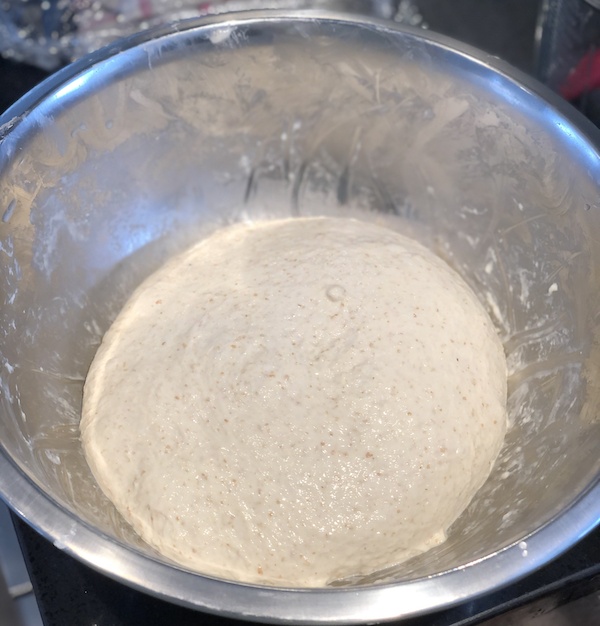
After bulk fermentation, too much?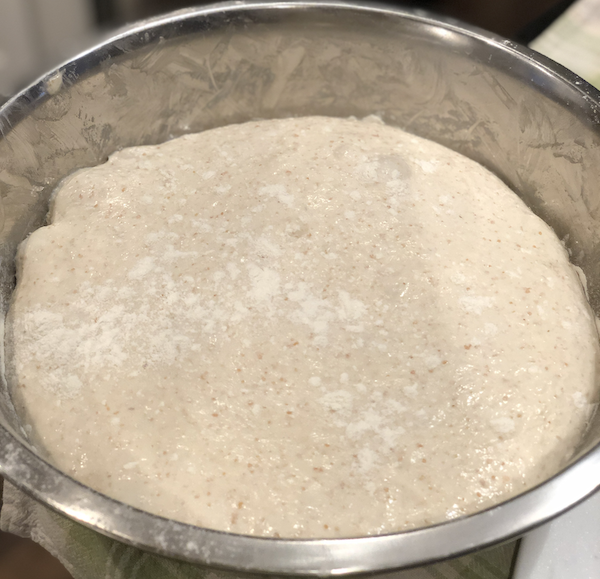
Shaping was a nightmare: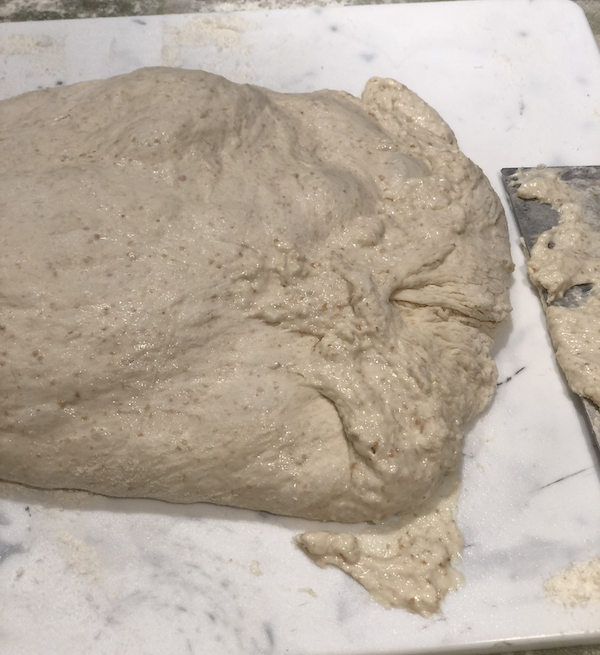
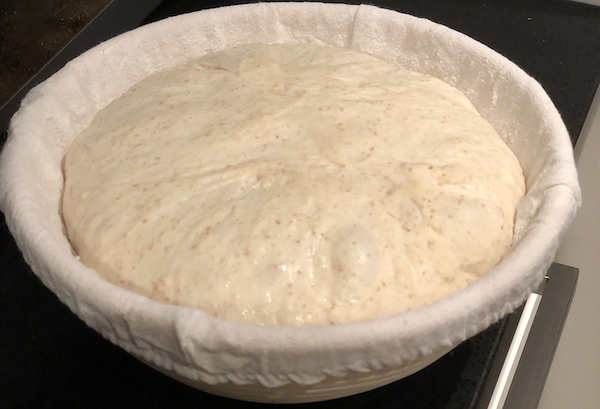
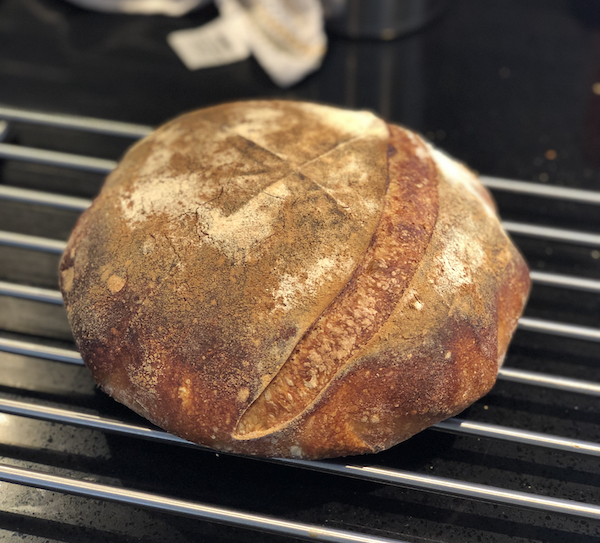
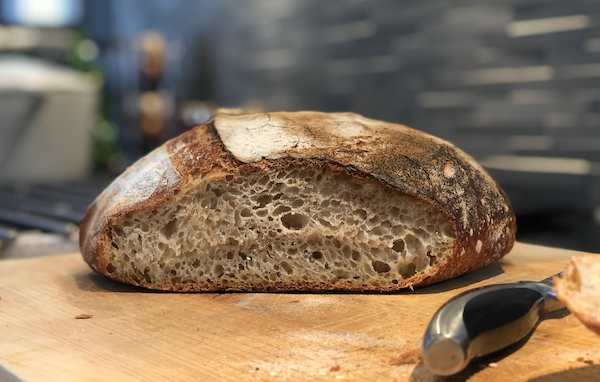
Your starter is doing something as I see a nice crumb structure. Agreed it's a bit flat however the interior looks very nice. How does it taste?
The flavour is very good. Acid is present, but not overwhelming. Wife loves the flavour. The crust is especially tasty. I'm not sure where to focus my efforts to get some oven spring. The spread you see when I scored it appears as soon as I make the incision. It literally spreads open before my eyes. I'm not getting even a tiny bit of oven spring. I used to preheat to 500 and then lower to 485. This time I started at 485 to see if it would help. No difference.
When you score then the problem is happening before the bake. Perhaps the problem is timing and/or the scoring itself.
How about an experiment? Final proof seam side down then when you flip the dough over the seam will act like a natural scoring so no need to score the dough. If this helps then we'll be a step closer to solving this on-going mystery. Also try your best to get a taut skin when shaping.
Sounds like the bread is a hit and the only downside is the lack of oven spring. If the issue was gluten breakdown because of an overly acidic starter or over fermented then one would expect a very sour loaf but your has good flavour.
Sounds like it's a little overfermented, but great looking bread otherwise. (what I noticed is the 2 hour warm proof and then overnight fridge retard - I never do more than a ~15 minute warm proof if cold proofing overnight). Normally final proof at room temperature is somewhere in the vicinity of 2 hours total, not with additional cold proof (obviously varies wildly by bread type, but that's a rough guess on average).
was the bulk, Ilya. If it was 2 hours warm final proof then in the fridge then agreed... definitely no need for that and might point to over proofing.
Mark... if you're warm final proofing anything more than 20 minutes ish before refrigeration it might be too much.
That's where I got this from, seems pretty clear to me... And the recipe below also says to proof until size increase 20-30% and then move to fridge.
After I saw your comment I went to check but just looked at the outline which never mentioned the 2 hours.
For the final proof I said leave out for about 20 minutes then refrigerate.
Understandable now.
I see! Understandable, some misunderstanding happened. 20 min warm proof makes much more sense than 2 hrs :) Still the bread looks great, excellent crumb.
Makes nice tasting bread and crumb is good. Everything else is just timing.
Easily solvable.
Good observation gentlemen. As you can tell, I am a beginner and I'm mixing and matching different techniques in an effort to uncover what I may be doing wrong. Some have expressed surprise that I'm using stretch and folds along with the kneading. I literally have no idea what I'm doing HAHA but I had heard a few times that extra stretch and folds won't hurt anything, for me it was just a way to eliminate inadequate dough strength as an issue for my poor rise.
Use half the amount of starter, ditch the entire s/f routine and go straight to bulk after mixing. Enjoy!
Mark, the crumb you achieved is gorgeous. I think that your dough over fermented. Have you checked your fridge temperature with a glass of water on the shelf in the spot where your doughs will cold retard? If your fridge is much more than 5-6ºC then your dough will continue to ferment the whole time it is in the fridge. If it is below that, it will still take a few hours to get down to fridge temperature and will continue to ferment.
I will sometimes shorten bulk and make up for the lost fermentation during final proof and have successfully baked bread that had 2 hours or final warm proof. But generally speaking in these situations I'm going to the freezer for 30-60 mins and then baking, so I'm not leaving the dough for many many hours. Or for a Hokkaido milk bread where the final proof is in the pullman pan for 6-8 hours.
I think you're really close there, just a bit over.
Benny
I have checked my fridge temp, and it is around 3°C...
I believe the consensus us that I'm probably over fermenting because I have this constant fear that my starter is weak and slow. I'm not experienced enough to know the visual signs. I think I may be doing too long a bulk fermentation and too much proofing.
Good to hear the crumb is respectable. :)
Hi Mark,
I'm only moderately experienced myself, but at some point I also almost gave up on sourdough, so I sympathise completely.
About the starter:
Are you currently (for the loaf in this post) feeding your starter with AP/bread flour? In your other thread a few commenters suggested feeding 100% wholemeal rye at 100% hydration. Did you ever get around to trying that?
Did you feel good about this mature starter build before mixing it into the dough (consistency, smell, appearance etc.)? What was the formula? How long did it take to peak at what temperature?
The oddest thing about your starter is that you say it is unpredictable from day to day in response to the same feeding. (At the same temp?) Just from the pictures of your bread, I wouldn't immediately think there's something wrong with your starter.
About the bread:
I suspect this particular loaf was slightly over-fermented. That agrees with not a lot of oven spring, but an excellent crumb structure. Counting from when the mature starter was mixed into the flour (which one should), bulk fermentation was 4.5-5.75 hours, which may or may not be long depending on the fermentation temperature, but from the pictures it looks like the dough has doubled in volume, which may be more than you want. A very fully bulked dough is a) harder to shape for beginners, and b) makes it more important to keep a close eye on the second proofing. But in turn, retarding the dough after shaping makes it hard to monitor the degree of fermentation.
What was the degree of gluten formation after kneading in the mixer? Is there some reason you decided to add stretch and folds? What prompted the fermento-lyse (autolyse with starter) and reserving the salt?
May I recommend an experiment? (Yes, sorry, another one.)
Bake a bread with:
Total flour weight 500 g
Hydration 65%
Prefermented flour 15%
425 g white bread flour
250 g water
8-10 g salt
150 g mature levain (100% hydration, 100% white flour)
Mix together flour, water, salt, levain. Knead until full gluten development. Set aside to bulk ferment.
Personally, I think judging the end of bulk by volume is difficult for sourdough. Commercial yeast dough, yes it works, but sourdough...We really only want to know that the dough has fermented and therefore developed some strength. How to evaluate that? If one gives up on volume as an indicator, then it is possible to judge by directly handling the dough. When your dough shows visible signs of fermentation (If you have a plastic or glass bowl, then it is highly recommended to use that since you can see air pockets on the bottom.) or it has been a few hours and you think the dough should show visible signs of fermentation, gently perform two coil folds in the bowl with damp hands, one in each crosswise direction.
A) The dough should feel lighter and well-aerated when you pick it up, very different from just after kneading.
B) After the folds, let the dough rest for 5 min. It should hold the rounded shape, particularly at the edges.
Be gentle, but it's impossible to not deflate the dough at all, so don't worry about that. If A) an B) are both good, then end bulk fermentation. If not, let it go on for a 30-45 min and check again. When in doubt err on the side of a shorter bulk. The banneton will give some shape to the loaf, so we can 'cheat' a little.
Pre-shape. Rest. Shape as desired.
Final proof at room temperature. This is when I think it is useful to use volume as an indicator. Wait until the dough has increased at least 50% in volume and is billowy when the banneton is gently shook. The centre should be slightly domed and soft when poked. The indentation should fill in after a minute or so. Apologies for the vagueness but it is difficult to gauge volume increase in a bowl shape. But I would proof close to the state of a commercial yeast dough of the same weight in the same banneton.
Preheat oven/dutch oven. Stash the banneton into the fridge until ready to bake. If you think the dough is over-fermented, or it is very slack when turned out of the banneton, then consider not slashing before baking.
The rationale for this experiment is that it's not clear why this loaf is flat. It could be the starter, but it could also be formula or method. (Or the latter in combination with the former.)
That was...a lot of questions. I hope you don't mind.
Many good points here. I have taken all of the above into consideration. I will try the experiment and will report back. There seems to be a theme about over fermentation and it makes sense. I am always worried that my kitchen is too cold and that my starter is too weak. But I'm starting to realize this may not be the case. I've been checking the temperature with an IR thermometer and my kitchen is actually 21.5°C, even though my thermostat is set to 18. So not as cold as I thought.
Mark, it's a beautiful loaf and your starter obviously works, great crumb!
Your dough is very soft for some reason, soupy even. This does not look like 60% hydration at all:
It looks closer to 120% hydration, very soupy, more suitable for focaccia or pizza in teglia. I baked a 100% hydration sourdough bread today using Five Roses all purpose flour and it looked firmer and tighter than your dough.
I was testing the performance of my newly created Bittman's starter, so this is whole wheat APF.
Starter fed 1:2, 4 hrs at 28C,
dough bulk fermentation 2 hrs at 28C,
proof 2 hrs at 28C,
bake 1 hr at 350-400F (180-200C).
Are you using a scale?
Are you in Toronto? I could test your starter by baking with it if you give me a small sample of it. One tablespoon is enough. I am in High Park area. By description and results is sounds nice but your dough consistency and texture is suspicious.
Hi Mariana, I am in Whitby and also with problems, just like Mark. I wanted to ask what flour do you use? so I could try it too and eliminate blame on flour, lol
thank you
Elena
Hi Elena,
RobinHood all-purpose and RobinHood Best for Bread are excellent flours, very tasty and fragrant in bread. I feed my sourdough starters exclusively with RobinHood flours.
I personally love FiveRoses all-purpose flour as well, especially for baking with yeast: baguettes, pizzas, etc. It is more delicate than RobinHood.
Which flour is the cheapest in your city? Do you have nofrills stores and noname brand flour there? It is very good for baking breads as well. Not as luxurious as FiveRoses or RobinHood, bit still very reliable and I like baking with it.
Best wishes,
m.
Hi Mariana,
I have like 6 different packages of flours, I would drive to places to get special flours, instead of going to Nofrills, lol
I have organic flours from Ardent mills, called Keynote, bread and AP. I have organic flour from Tyrone mills, also bread and AP flour. I also found K2milling, I got Dave Black white bread organic flour and Ferdinand bread flour.
I feed my starter with 25% rye and 75% bread flour from Tyrone mills, 12.4% protein.
Nothing helps me, lol. I will go now to Nofrills. Another try, another flat. lol
but I didn't want to hijack Mark's thread, I will start my own, I have photos to show.
Elena,
use unbleached noname, FiveRoses or RobinHood flour as you gold standard, please. These are very tolerant flours, impossible to screw them. Only FiveRoses is suitable for hand kneading, though. 20-30min of kneading by hand would develop its gluten enough for the French style bread with nice ears, etc.. Noname and RobinHood must be kneaded in a mixer, bread machine or food processor.
Every other flour would require adjustment to account for its idiosyncrasies.
If you recipe does not work with any of them, then the problem lies either with the recipe itself or some other ingredient, including the choice of yeast or the starter.
Every great bread starts with a great recipe, reliable and tested, accompanied by the illustration or your personal experience, i.e. you saw that bread irl, you ate it. If that same recipe produces a mediocre bread in your kitchen, then there is either something wrong with the ingredients or the baker misunderstood the recipe or did not follow it as written.
I saw the pctures of your last test bake and can say two things
1) looks terribly overfermented, baked from the dough well past its prime, depleted of sugars, etc. By that I mean that in a purely yeasted bread, overfermented dough would look like that after baking it.
2) my very first sourdough looked like that and the culprit was the starter. The flour was perfect, the bread recipe as well. Once I got myself a better starter, the bread magically changed.
Hi Mariana, thank you, are very generous.
I will use Robin Hood flour today.
I just refreshed my starter with 1:1:1, and I will make dough with Robin Hood flour. I will make 80:280:400 (starter/water/flour) recipe with 2% salt. I will proof at 26C to 20% increase and then shape, then fridge for the night, then bake at 450F, but will preheat to 500F, so when opening the oven there will be heat to lose. 15 min in a dutch oven, and 15 without the lid.
About my last bread - the over fermenting is there, but I am feeling the starter has problems too. Although it rises steadily to 200-300%, it seems it doesn't have that potency in the dough. Can it be so?
Do you know where I can buy a good starter? I would love to give it a try.
And about the starter. Is it like 'John Doe' bacteria which will be multiplying forever and all generations will have Doe name? or it's a bunch of bacteria from one group, they come, multiply, and mix and then nobody knows who is who?
I thought it's the latter.
Elena I’d be more than happy to give you some of my starter. I live in downtown Toronto, if you’re ever going to be downtown I could leave some at the front desk of my condo for you to pick up.
Benny
Elena, I know that good starters are sold in Canada, most likely in health food stores or on Amazon.ca, but I never tried them, so I can't tell you where in Canada to get them. I got great starters from Cultures For Health, for example.
https://shop.culturesforhealth.com/collections/sourdough
My own is homemade, Nancy Silverton's from La Brea bakery starter. It is very powerful and steady. I can mail you a sample in an envelope on Monday if you wish. You will be able to restore it with one or two feedings, especially now, that you have RH Best for Bread Homestyle White flour.
Starters tend to have a very steady microflora with the same species of bacteria and yeast staying unchanged for weeks, months or sometimes even decades. It has been proven by the lab experiments. For as long as the maintenance and feeding ratio is the same, their bacteria stay the same.
So what you said about John Doe bacteria and Jane Doe yeast species is right. They will forever stay the same, their kids and grandkids will continue the same line inside your starter.
It's like dogs will continue to be dogs, not bears nor cats. Although those dogs might change somewhat in responce to a different kind of flour that you feed them or different temperature and other selective pressure, and you might have great Danes becoming chihuahuas or mutts, but they will still be dogs, not bears and not cats. In sourdough bacteria those differences within the same species are called strains - different strains of the same John Doe bacteria will have slightly different aromas or gassing power, or acidity, etc.even though it's the same species of bacteria.
That said, sometimes starters change suddenly, sometimes they get sick, lose aroma or become gluey, or develop huge growth of fuzz on the surface, viruses attack bacteria in the starters, other bacteria or fungal speces invade, etc. So it is good to have a backup or a quick recipe for a starter to keep baking. You can make a great starter from a slice of bakery bread as well, it will take about 36hrs and it will be ready to bake with it.
- I am feeling the starter has problems too. Although it rises steadily to 200-300%, it seems it doesn't have that potency in the dough. Can it be so?
- 100% hydration starter should about quadruple in volume. However, yours is wheat-rye mix, so its volume is not important, it tells you nothing about its maturity. Other signs of maturity will be more important. For examle, how quickly it doubles again, if stirred down to the initial volume( hint: a mature, ready to use in bread dough starter will double in less than one hour at 20-22C). For example, its potency in dough, its pH and TTA (total acidity). It should make bread dough rise about 4.5 times in volume in 6-8hrs at 27-28C.
If your bread dough is overfermented, then it won't rise spectacularly, because there is no sugar in it for yeast to eat and produce enough gas for the explosive growth in the oven. No matter how great your starter, if it is starving, because there is no sugar left in your bread dough, it will be unable to lift it, to produce great oven spring.
100% hydration starter quadrupling? Literally never happened to me, it can never go over doubling! But can still make great bread. Is that your experience with super strong North American flours? Or is it something else?
Tbh I actually keep a rye starter, but often make levains with 100% hydration with mostly white flour. But whatever I do, I have to lower the hydration to go over 2x growth.
I know absolutely nothing about all of this, but I can say that my starter has gone way past quadrupled in some instances.
Hi Ilya,
My flour is rather dry, maybe that is a contributing factor? If your flour is above 10%moisture and mine is below 10%moistire it will affect the outcome. I do not know.
Flour strength or protein content has nothing to do with it. It just has to be all purpose or bread flour. European bread flours with 10%protein content behave in the same way. Flour from England, Sweden, Norway, France, Poland, Belarus, Ukraine, etc. Always the same.
It just has to be kneaded well, that's all. Preferably fortified with diastatic malt and vitamin C. I don't just dump some water and flour and stir it a couple of turns. I mix it, i.e. I whip it, to see the first signs of gluten development and let it rise. It looks like poolish when ready with giant transparent bubbles of gluten on the surface.
If your starter's gluten is digested or damaged it would affect its behavior as well. It will no more than double then. I don't let a 100%hydration preferment or levain to collapse either. I stir it and let it rise over and over again, quadrupling several times in a row if necessary, until it is ready to be used in baking - having attained right flavor and acidity.
100% rye starter would also rise high, about tripling or quadrupling, bubbling ferociously and run away if allowed to :)
Yeah humidity also occurred to me as a factor, but that's something more difficult to control/check. I can try stirring it vigorously for a minute next time. When I make a stiff levain it triples easily. When I tried a more liquid levain for some Hamelman recipe (125%, was a long time ago now), it didn't even double, although it was frothy and raised the bread just fine.
But my 100% rye starter also never goes beyond 2x! And I know it makes bread :) Interesting. Could it be something about the softer or harder water too? Just grasping at straws here.
Ilya, my 100% hydration rye starter generally rises 3.5-4 x at peak. I used to think that my bread flour levains weren’t very active compared to my whole grain levains all done at 100% hydration until I spent a bit of extra time stirring the levains to develop some gluten. It was a relative lack of gluten that was preventing the levain from rising sufficiently so my bread flour levains rise 3x easily, but 4x I don’t think I’ve ever seen. For that I’d have to thicken the levain up a bit.
My rye starter even when very active (i.e. grows very quickly) never goes beyond 2x either!
This I cannot explain since there would be no difference between vigorous stirring or just stirring enough to make sure all the dry bits are hydrated. I’m assuming you use filtered or bottled water.
I know you bake excellent bread with it, so I don’t understand why your starters don’t rise more. I’m sure you’ve tried to invigorate it by keeping it out on the counter and giving it multiple feeds for several days to see if it will strengthen.
When I just created my new rye starter in Moscow it was so fast, it was just jumping up so quickly! But never more than double... There I indeed was using bottled or filtered water. In Edinburgh and here in Basel tap water is great, so I just use it.
Perhaps, following from mariana's suggestion above, flour is more humid in Europe? I wonder about others' experience with this in different locations.
I also keep a 100% rye, 100% hydration starter and it also never rises more than 2-2.5x. Definitely no more than double if used to make a white 100% hydration levain. It makes bread fine so eventually I stopped worrying about it, but it's still reassuring to hear someone else's starter does that as well. So much sourdough advice emphasizes that a vigorous starter should rise 3-4x at peak.
I'm in sub-tropical East Asia but use mostly UK/French flour. Is it really the humidity? Difficult to test for...
Thank you for sharing your experience, indeed it's reassuring for me too :) I guess subtropical East Asia where you are has a humid climate? So that would align with the hypothesis. But we needs way more people from different regions to share their starter growth heights.
Well-well, today it tripled! The main unusual thing was that I barely had any starter left in the jar, maybe 1g plus whatever was dried up on the walls. And I fed 35g each warm water and flour. So a very high feeding ratio, that I usually don't do. I wonder what ratio you typically use, Benny?
Also maybe it was the first time I used a new brand of flour for feeding the starter, but I'm not sure, could be the second time.
And even with such high ratio it about tripled in 12 hrs (or earlier, but I was sleeping).
Interesting. Very interesting. I suppose the real question is...did it/will it make better bread?
I put it in the fridge after feeding, so no idea! But I doubt it to be honest. Maybe the dough would rise a little faster, but I am doubtful the result would be better...
Ilya, my typical feed is a minimum 1:3:3. That’s an impressive rise Ilya. Prior to that feeding what ratios have you usually been doing?
Ok, thanks. I usually do at least 1:2:2, but not really consistently. The previous feeding was also higher ratio, but not as extreme.
Absolutely beautiful loaf! I would be ecstatic if I saw that kind of oven spring. As for the hydration, this has been a sticking point for me, no pun intended. I have tried the Tartine Country Loaf recipe 3 times, and every time, I ended up with a soup in the bowl. In this latest attempt, I am following the same recipe, but more loosely, using 300g of water instead of 375. And yet, the dough is so wet that it is impossible to manage. I have made high hydration yeast bread with little issue. I have learned how to handle the dough. But with the sourdough, it seems to start off fine and manageable, but then turns into this wet mess after bulk fermentation. I have a strong suspicion that many people are right about this bread being over fermented. Would a suddenly overly wet dough perhaps indicate that it is over-fermented?
As for trying my starter, that's a neat idea! I am not in Toronto however, I'm in Montreal. I'd be happy to send some by mail though! That would be a neat experiment!
Yes, Mark. A suddenly wet and sticky dough means its gluten started releasing water, over fermented for sure. Your starter is probably very strong, very good.
I would have to try your starter with the recipe that I trust to be sure though. If your sourdough behaves too differently from yeasted dough, something suspicious is going on. We'll see.
I have never met a more helpful and kind group of people online ever before. Truly, the kindest.
Mark, what Mariana said: that dough doesn’t look like 60% hydration or even 63% which is what your formula comes out to (the 100 gr levain is counted as 50 gr flour & 50 gr water in determining total dough hydration). That looks like 72-75% hydration, which will definitely give you shaping problems if you aren’t used to working with high hydration doughs. Small side note: Your levain is only about 10% of total dough weight. Typically levains run 15%-20% of total dough weight. Increasing the amount of levain may benefit. Also, if you are proofing in the banneton for 2 hrs and then putting into the fridge overnight, you are definitely going to get little or no oven spring as the loaf is overproofed. At our bakery we gave shaped loaves only about 45 min at room temp before retarding them overnight at 38 F. Lots of oven spring next morning.
Thank for your this information. I just made some potato-enriched buns using yeast and they came out absolutely incredibly. When I work with yeast, I have a much better sense for the visual markers. The dough doubled in size and felt exactly how I expected it. I'm still in the dark when it comes to sourdough. Are the visual cues the same? Maybe I'm expecting the same behaviour from my sourdough as I am from my yeast breads -- which I have a lot more experience with...
There is always a wet shine to my sourdough that I'm still not sure is right. When I watch videos from people who make sourdough, their dough does have a sheen but not a wetness like mine always show. You can see it in pics above. Even in the first dough, you can see it looks as though I've sprayed it with water. By the time I'm ready to shape, it's so fluffy and loose...
Doughs using levain/sourdough generally need a longer primary fermentation period than yeast-driven doughs. Instead of 1 -1/2 hrs, expect 3 hrs, sometimes more, with degassing and folding at 90 minute intervals. Final proofs may also be longer: instead of 1 hr, perhaps 1 1/2 hrs if you don’t retard the loaf. Either way, the finger poke method is reliable: poke 1”. If dough springs right back up, it’s under-proofed. If dough springs back halfway its ready to bake. If the indent stays without springing back, it’s overproofed. This only applies to doughs baked same day as mixed. If you retard, no poking is necessary - bake right out of fridge.
Just fyi - wet shine, along with stickiness I'm sure, is an excess of free ie uncombined water. That could be anything from just too much water for flour used to gluten engine issues (and many things between). A well formed dough with proper amount of water should not look shiny or feel sticky. Enjoy!
The visual cues...are not completely different, but sufficiently different to sometimes make it harder to switch from commercial yeast to sourdough than just coming to bread baking with sourdough completely new. For the longest time I just could not get a grasp of controlling sourdough fermentation and it was very frustrating.
Mainly, I think sourdough is more sensitive to timing. As you say, volume is a reliable indicator for commercial yeast dough. You let the dough double, however long that takes, and you're good to go. But if the dough triples, it'll probably still be fine, particularly during bulk fermentation. You can just degas more thoroughly. Sourdough...it takes time and some trial and error to learn the tendencies of your starter and how it behaves in a dough. From the moment you mix the mature starter into the dough, the clock has started. There's a limited amount of time before the gluten starts to degrade in which kneading, rising, shaping, second rise has to happen. So the length of bulk fermentation cannot be unrelated to the length of final proofing.
Let me see if I can take some pictures next time I bake of what one can look for in terms of visual cues.
How is your starter doing lately? Starters can exhibit vastly variable behaviours and still make good bread, but unpredictable behaviour is rarely a good sign.
Mariana, you keep stunning me with your generous information!!! thank you so much
After reading what you said about the starter, it is clear that my starter is not strong enough.
I would love to have Silverton's starter!!! I will PM you.
Benito, thank you so much for your offer, I thought I would get it, but then Mariana offered me hers, I can't resist!
I reiterate Mark's words, it's an incredibly good aura here on this forum, and it's all because of people. Thank you all!
I attempted the Tartine Country loaf again, and made the the following adjustments based on what I have learned so far.
1. Did a four-hour autolyse before adding starter and salt. This had a HUGE effect on the dough. It felt completely different than every other time I made it. I even used the full water content (350g water to 500g flour) and it was still very manageable for me. Not soupy and shaggy like it usually is for me.
2. Used a glass bowl, to allow me a better view of bulk fermentation. Many people pointed out that my last attempt appeared over fermented, so I tried to pay very close attention to it this time around. I pre-shaped the dough after 4 hours of bulk fermentation. It had grown about 20% and I saw quite a few bubbles on the bottom and sides of the bowl. Again, the dough was a dream to work with at this point.
3. After shaping the dough and transferring to the banneteon, I left it out for about an hour before transferring to the fridge. There was absolutely no sign of life in dough at this point. It didn't rise at all in the banneton. This morning, 18 hours later, it looked exactly the same as when it went in. Absolutely no change in size or feel. Poke test felt under fermented, poke hole instantly popped back out flush. Allowed the dough to warm up about 2 hours, and still no sign of activity. Baked as usual, and opened the lid to the familiar flat bread I'm used to always seeing.
Here's a breakdown:
450g bread flour (Robin Hood)
50g whole wheat
350g water
100g ripe starter
10g salt
Mix flours and water until combined, autolyse 4 hours covered.
Add starter and salt, mix in stand mixer on low until combined, transfer to glass bowl, covered, for 30 minutes
Stretch and fold, rest for 60 minutes
Stretch and fold, allow to complete bulk fermentation.
Pre shape, rest for 30 minutes
Shape dough and transfer to banneton, rest for 60 minutes.
Preheat dutch oven to 500°F, bake covered @ 485 for 18 minutes, remove cover and bake until dark. (30 minutes).
12-hour old starter:
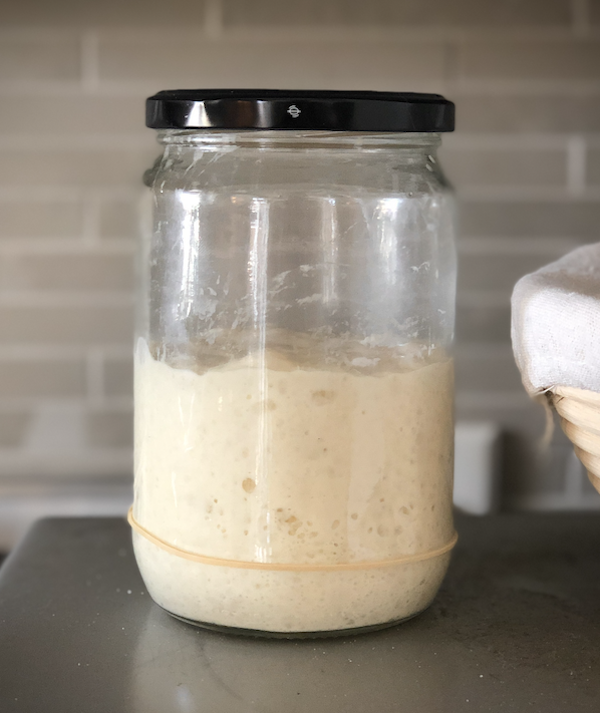
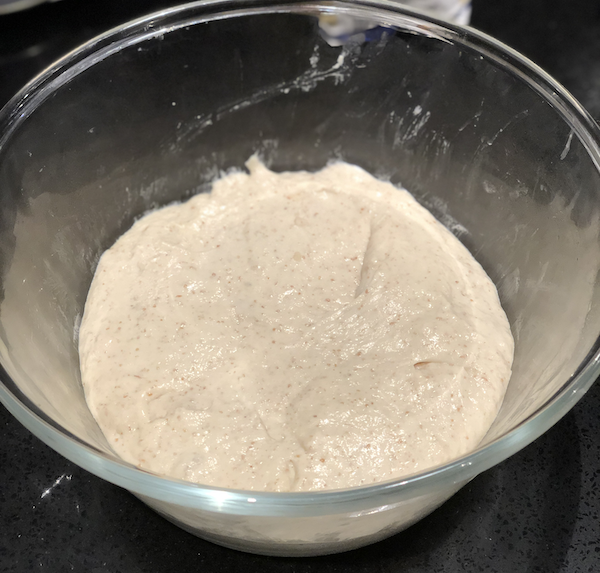
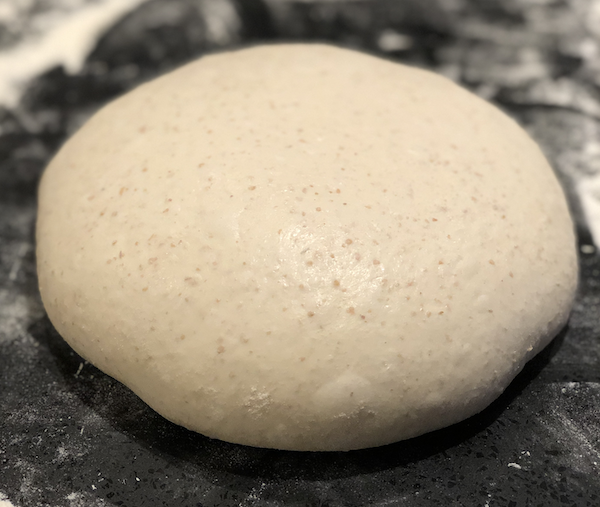
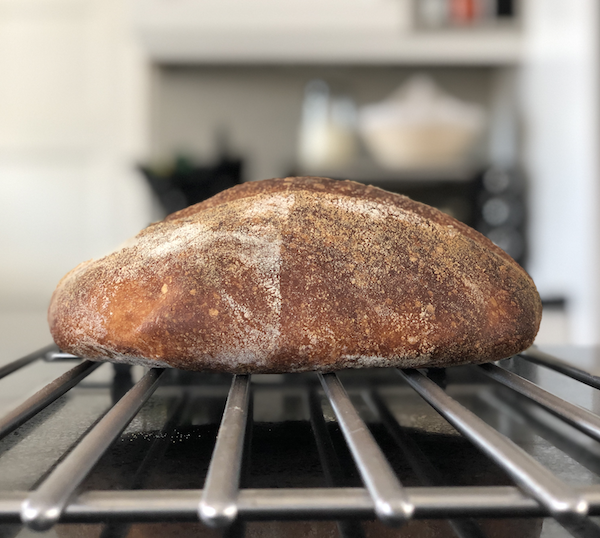
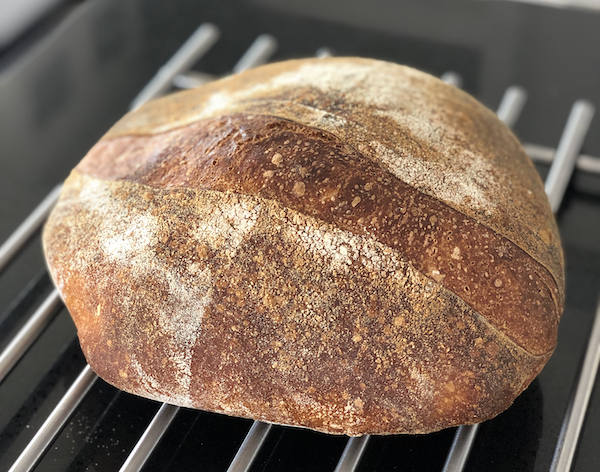
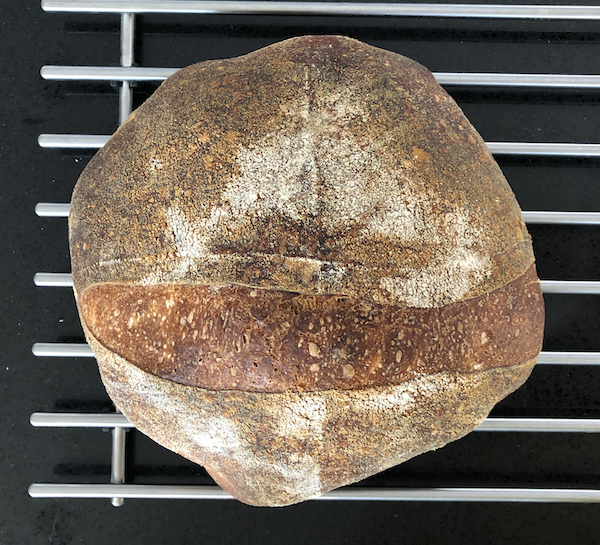
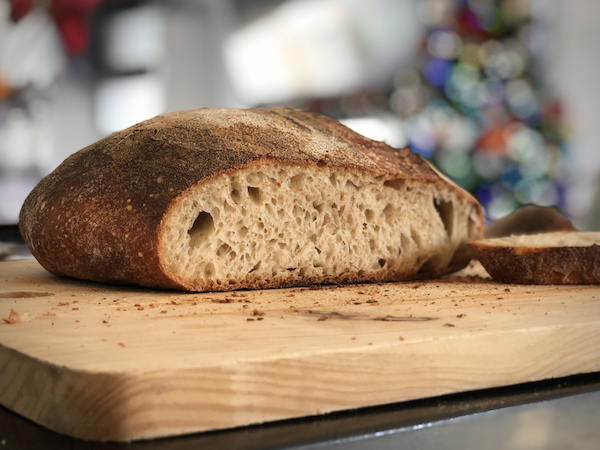
Smooth dough, finally looks right!
Pre-shape went super well:
Yet another flat bread:
You can see here how wobbly the shape is:
Overall, I am super happy with the flavour, it tastes really amazing. The crust is very crispy and flavourful. My only complaint, as always, is that I get no oven spring.
What I have learned: The long autolyse made a huge improvement to the dough's "workability".
Thanks everyone! And have a great weekend.
Hi Mark! After reading your current post then going back through some of your other comments, a couple of things popped into my head. Apologies if you already answered these in some of the other comments.
1. What ratio are you feeding your starter (1:1:1 or 1:2:2 or more?) and when is it peaking? 12 hours for me with a straight 1:1:1 feed would be well past peak time for use. I've had the best loaves from freshly peaked starter, before they start getting more acidic. Also, what kind of starter is it? It looks like a straight white starter but I can't tell from the photo. Some percent of WW and/or rye might help. I usually mix approximately 50/40/10 (% of WW/AP/rye respectively) but I also maintain a straight AP flour starter for pizza doughs and focaccia.
2. You might try allowing fermentation to continue until closer to 30 - 50% rise. When are you taking a piece of dough off and placing in the jar? This is important that it done at the right time so you get a true indication of where your dough is. Benny provided some excellent info here before: https://www.thefreshloaf.com/node/64897/aliquot-jar-determine-bulk-fermentation-rise
3. Shaping issues could be contributing to the dough strength and ear issues if you are not forming the loaf properly during shaping. The photos do indicate kind of a loose irregular shape rather than a tight structure. Additionally, only 2 S&Fs (if I am reading your notes correctly) might not be enough to build up strength in the dough. You might try to incorporate some coil folds in after the S&Fs. You could adjust your timings to a couple S&Fs at 30 minute intervals followed by approximately 2-4 coil folds at 45 minute internals, then allow to complete bulk ferment.
4. After fermentation is complete, I usually place the covered banneton either directly into the fridge (if I haven't pushed fermentation too far) or I've even popped the banneton into the freezer for 15 minutes to arrest fermentation then will place it in the fridge overnight, approximately 12-14 hours max...we don't like our bread too overtly sour here. You don't need to leave it on the counter at room temp after shaping unless you are trying for more fermentation. However, it sounds like your dough might have been out of gas if you didn't notice any more rising in that hour or after a night in the fridge. I don't see much activity in the dough after a night in the fridge but there is usually some growth, which also suggests your dough may have been over-fermented. Of note: doing the poke test on dough that has been resting in the fridge overnight will provide you with zero information about proofing--the dough is cold and stiff.
5. There is no need to bring your dough to room temp before baking the next morning unless you have cut short fermentation/proof the previous day (which does not sound like that was the case). You can bake directly from the fridge in the morning. This helps with scoring as well as cold dough is much easier to score. You may not be scoring deep enough or at the right angle but I think the ear on your loaf is more an indication of fermentation and dough strength issues.
6. Are you letting the DO and oven get pre-heated for a full hour at 500 before baking? This will help with oven spring. I usually bake at 500F for 25 minutes lid on then 450F for 20 minutes lid off, plus another 10 minutes in the oven after it is turned off. The early, hot heat is what assists with oven spring, especially with a cold dough. This is another reason NOT to bring your dough up to room temp for 2 hours prior to baking.
I'm certainly no expert but I've baked a lot of bread over the years. You are in excellent hands here with those who are more experienced than myself. However, although the crumb on your loaf looks pretty darn good, I think you may be over-fermenting your dough and not working enough strength into it in the early stages. It sounds like it tasted amazing, and that's the most important thing! Hopefully I haven't drowned you in words but I do hope you will find something helpful here. Wishing you luck on your baking adventures. Do keep us posted!
Hi Naturaleigh,
Thank you for your tips. It is very appreciated. I am taking in all that I can from everyone's tips and suggestions.
My starter gets fed different rates as I try to fine tune it. But I admit I am really not consistent with ratios. I do feed it every single day so I'm disciplined in that regard, but some times I do 1:5:5, other times 1:1:1. The bread I posted right above your post was made using a starter fed at 1:2:2, but I realize the starter peaked about 8-12 hours after I used some of it. So I guess it was not ready. I tried the same recipe again today, and used 1:1:1 starter, which had tripled in size in 8 hours. But again, even after using a bunch of it, it didn't start caving until later.
So I tried the same recipe again today, hoping to apply some of the things I learned in your last post, and it was yet another disaster. I'm at the point now that I have to stop. I think it's time to throw in the towel. It's not good for my mental health anymore. I have baked 10 sourdough loaves in 6 weeks, and despite paying closer and closer attention to the details and trying different techniques, I always get the exact same loaf, which is a tasty loaf that is flat like a pancake. At this point, I am completely dejected.
As for pinching off a portion, I have never tried this. I definitely see the value in having a gauge to refer to, but I haven't tried it yet.
For the shaping issue, I thought I'd try to make sure I have sufficient dough strength per your suggestion. I did a 4 hour autolyse, then added the starter and salt, and kneaded in the mixer for about 5 minutes. It was immediately much better to handle. Then I did three sets of stretch and folds, 30 minutes apart, and it felt like a taut little ball in the bowl. I thought I was doing good. I let it bulk for approximately 3 hours total, and decided it was time to shape. When I flipped it out of the bowl, it rolled out like pancake batter. The same exact thing, every time. I cannot understand it. Why is my dough losing all of its strength in the bulk fermentation stage?
I pre-shaped it by tucking the sides in using a dough card. It looked great on the counter, but it was still flat. I let it rest for 30 minutes. When I went to do the final shape, I noticed the centre was like a parachute. Upon closer inspection, I realized as I was tucking in the bottom to make the top tighter, it was actually rolling up like a donut, or a rolled up sock. What a disaster. I ended up losing my patience and balling it back up and shaping it like a big hamburger bun. Unbelievable. I threw it into a banneton and threw it right into the fridge. I'm starting to get quite frustrated with myself.
As for the poke test on the cold dough, what you point out is what I suspected, but I wasn't sure. I'm glad I have confirmation now. I really don't know how to read the signs of when this should be ready. I never know how far along I am in bulk. This time I used a glass bowl and it seems to have grown by maybe 40-50%. But I don't know why it became unmanageable. It was such a nice dough at first, then turned super sticky and was difficult to take out of the bowl gently.
Thank you for your very thorough post and detailed suggestions. You are very observant. I am a little too frustrated to post in detail now, but I'll update tomorrow when I've gotten some sleep.
Apologies for my negative rant of a post.
Starter tripled in 10 hours:
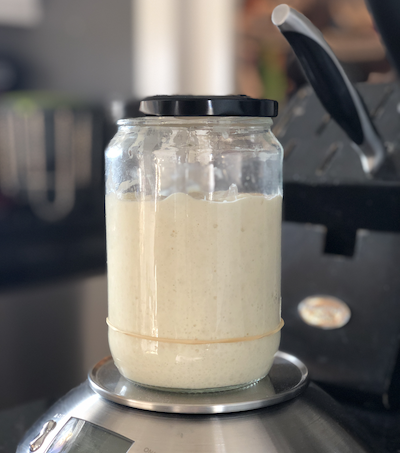
Mark I can relate to your frustration, I remember wanting to give up many times when I started down the path of making sourdough bread. Lots of frustration and little reward at first. It seems incredible but your starter seems super charged and or your fermentation temperature is quite warm. But your dough at the end of bulk, photo 3, you say had risen by 40-50%, actually rose by more than 100%. The vertical height of increase to my eye is more than double and the bowl doesn’t have parallel walls so the volume increase is really substantial. In fact you are greatly overfermenting your dough. During this time that it is fermenting to this point the gluten is getting broken down by the proteolytic enzymes which is why your dough flattens out to a pancake.
I would strongly suggest using an aliquot jar of some sort. A spice jar works well, or a medical specimen jar, but anything that is narrow and has parallel sides. Have a look at my post about how to use an aliquot jar it really helped me improve my baking and given what I’m seeing with yours it will make a big difference to yours as well.
So simple, your dough has overfermented. Slow it down by using less levain at your next bake because you want it to go a bit slower so you have enough time during bulk to develop the gluten and structure your dough needs to rise without overfermenting.
Benny
Thank for for the encouraging words. It's really quite baffling to me that I took the time to mark the height of the dough in the bowl, TOOK PICTURES OF IT, and yet somehow it never registered in my brain that it had more than doubled in size. It seems that subconsciously I am still trying to stick to the times suggested in the recipe rather than reading the signs that are right in front of me. I believe I also have this idea that my kitchen is cold, so I'm always giving everything extra time, when in fact it does not appear to be case. I felt the dough at one point and thought "wow it feels very cold" but when I checked its temperature, it was actually at 22°C.
I believe the next time I attempt a loaf, I will use less starter and monitor the signs more carefully.
Thanks again for the suggestions. I will try pinching-off some dough into a pill bottle.
Hi Mark! I'm so sorry to hear how frustrated you are...we've all experienced the same or very similar circumstances with our baking. I agree with the others that have responded to this post that your dough has over-fermented. I suspected this before (per my previous post) but now that you've provided photos of your bulk ferment progress you can clearly see it went too far. Given the mark on the side of your bowl, you could have stopped when it reached the top of the tape, when the dough would have risen half the height of where you started, or 50% rise (some folks here at TFL recommend to ferment even less, like 30%). Instead, it looks like it tripled in height and, as Benny pointed out, the bowl angles out rather than straight, so you've got a lot of volume growth there. Also to the point of a too warm kitchen, I actually experienced this last night while cooking as I was trying to complete fermentation on a couple loaves. I had to stop dinner prep and shape those loaves quickly as they nearly got away from me--I actually fermented at least 30 minutes longer than I should have but got busy and the kitchen was warmer than usual with having the stove and oven going. It happens!
So, don't give up! You are nearly there...I bet with one minor tweak of cutting down your fermentation time, you will notice a HUGE difference in shaping and the resulting loaf. Please keep us posted. You have a great cheering section here at TFL.
Thanks for your post. I saw it shortly after you posted it, and it helped very much. I indeed was very frustrated. But things are always better in the morning, thankfully. When you put it in perspective, it's just bread. Feels kind of embarrassing to get this frustrated when you look at the big picture of this world. I will try to remember that next time.
As I mentioned to Benito, I can't believe I took the time to mark the bowl but completely overlooked how much it had grown. I think part of that is also because I feel like the mark becomes meaningless once I start doing stretch and folds, where the shape of the dough is different afterwards. But really, it is painfully obvious now, looking at the pictures, that it had more than doubled, possibly even tripled in size.
I'm surprised that my starter is this powerful, this whole time I was under the impression that it was weak.
I will try again, in a few days. :)
The morning after this highly discouraging evening, I baked the loaf. Considering that I basically beat the crap out of it and made a ball and threw it in the banneton, it actually came out better than any of my previous attempts! Imagine that. :D
Definitely in the right direction. Still a bit too much fermentation so reducing fermentation will still definitely help Mark.
Benny
Thanks Benito!
Phaz's suggestion seemed like a great idea to me. I got control of a soupy dough problem by reducing starter and water. I later was able to use more water. I found many recipes worked better with less starter.
Also kitchen temperature has a huge impact on how quickly your dough will ferment / turn to soup. Again, less starter might help here by slowing things down. I got a thermometer and started tracking kitchen temps... they ranged from low 20sC to high. A difference of 6 degrees C has a huge impact.
Also consistent feeding proportions are important to gain control of your starter.
Also you can search for info about thiols in starter turning dough into soup (brought up by mini oven here on TFL)
I think if you are feeling a lot of frustration, it's a matter of thinking about the problem more conceptually in terms of how everything works together: yeast, lactobacillus, temperature, quantity, time. For me, scaling starter way back and managing kitchen temperature and reducing time made life way easier.
Thanks for the suggestions Happycat, I believe I'm starting to narrow down my issues. I have been operating under the impression that my kitchen is always too cold for bread, but am noticing now that it's usually between 21-22°. I have been much more careful with my starter feedings. I have been doing 1:1:1 for the last few days and it is rising predictably to over triple the size in approximately 10 hours. I think I will stick to this feeding schedule, and will use less starter next time. I will also use a pill bottle to better gauge fermentation progress.
To your last point, I have to say that is exactly how I am looking at it. Some days, it feels like I am thinking about my last loaf the entire day, while I do other things. Constantly thinking of what is happening, and thinking of all the signs with the starter and the dough etc... and it is all making sense. Like many of you have pointed out, I now believe that my starter is actually very healthy and I'm getting quicker bulk fermentation than I expected but failed to notice the signs.
But I'm not 100% convinced that something else isn't at play. I can't help but wonder, even if my bulk fermentation has gone way too far, why does my bread always look so small in the banneton. I can't shake the feeling that something is breaking down the gluten quicker than expected. My father in law started making sourdough about the same time as me, since about November, and every single loaf he has made is absolutely HUGE, he gets insane over spring and big large ear every time. I asked him to try this recipe, and it came out picture perfect on the first try. We actually did the bake I posted above in the exact same time, and compared photos during the process. His dough looked the same as mine up until the end of the bulk stage. His held its shape nicely, despite his dough bulk fermenting for 6 hours vs. my 3. In the banneton his grew another 50%, it was growing out the top of the bowl, then he fridge retarded it another 8 hours, and it baked into a huge beautiful boule. I do suspect that his starter is populated with commercial yeast, since he does not get even a slight hint of sourness. He mentioned that he started his starter with a pinch of commercial yeast, but he can't remember for sure. He is able to take his week-old starter out of the fridge and feed it and use it within 3 hours, which to me sounds much more like how poolish behaves. All of this is only to say, I'm still not certain if the gluten breakdown I am experiencing is normal sourdough behaviour, or if something else is also going on.
I did a quick search on thiols, and from what I am gathering, there would be an associated sulfuric smell. Mine does not show any signs of that. In fact, mine smells like a fresh poolish with a slight hint of yogurt.
Thanks again to everyone! The journey continues...
That really sounds like your father's starter is just commercial yeast and not a classic sourdough starter. If you had a pH meter you could easily check that. However, what you describe as the behaviour of his starter certainly points in that direction.
One of the things we learned in doing and applying research was the importance of the "laboratory". A recipe is not the same if all the contextual influences are not also the same. Some people ignore context and expect recipes to deliver the same results everywhere. Some people create a laboratory-like approach (Maurizio Leo of Perfect Loaf comes to mind). Some people are adaptive problem-solvers using heuristics-- they don't need a lab.
This is why it's helpful to map out a little model of the situation with its key factors. Then you identify which key factors explain part of the problem and are the simplest and easiest to address. You address them and rule them out. Then you go up to the next one on the list.
That diagnostic approach is driven by a model, and systematic.
I read an article many years ago on expert problem-solving vs amateur problem-solving and this was the method they described. Amateurs work backwards from their poor result and get caught up in everything all at once. Experts sketch out a model, identify key factors, and address them systematically one-by-one going from easiest and cheapest to most complex.
This systematic approach working from foundational issues is also a way of identifying situations where there are mutliple foundational causes for a problem: ie. strong starter + warm kitchen + lack of gluten development
Working systematically helps provide a sense of agency and progress. Even crossing off problems from a list can be satisfying.
Anyhow, hope this helps.
Hey Mark
Hope you haven't given up on bread. I had my own bread fail the other day and felt pretty bummed about it as it was a multi-day effort with hand-milling grain. I'd had a few days to visualize my ideal result but then got knocked back by reality :)
Best wishes
Hi Happycat ...
I have not given up ... completely. I baked two more loaves, each time a/b testing another variable, and this time using a spice jar as a gauge to monitor bulk fermentation, and I got the same flat bread yet again. My enthusiasm is almost completely depleted. I decided to stop and regroup, and focus my efforts on my starter. I found an insightful video about starters and have spent the last 7 days attempting to strengthen my starter per the video's suggestions. I am paying much closer attention to feeding ratios and watching peak time closely. It appears to be stronger now.
Today, I decided I would try a yeast-leavened loaf to completely rule out my starter as the culprit. The recipe is almost the same as the Tartine Country loaf, but it uses 280g of water instead of 350g, and of course a poolish instead of sourdough leaven. It started out great, but then at shaping time, it all fell apart. I baked it and it came out exactly the same as my sourdough attempts. Nice crumb, good taste, but flat as a pancake. The shape is all flabby too, so I think my main issue is probably dough strength. I may try one last time and knead for 20 minutes for testing purposes, but I don't understand why I would need to deviate this much from the recipe in order to achieve acceptable dough strength. And actually, it definitely tightens up during the stretch and fold steps, but then it gets slack again as it bulks. And when it comes out of the banneton, it spreads out super flat. So it's not high hydration, and it's not my sourdough composition. The only remaining variable is the idiot working the dough. Edit: I just actually did the math, and that's 86% hydration. But this is supposedly a beginner recipe. I dunno anymore. I'm so saturated I can't even think anymore. This is the recipe: https://www.youtube.com/watch?v=5mehXzl7yHA
I'm clearly not cut out for bread baking. I believe I've made 13 or 14 loaves in the last two months and I haven't had a single one hold its shape and spring in the oven.
Also, I almost forgot, I very much appreciate the post you made above, regarding troubleshooting. Funny enough, I am usually a good problem solver, used to work as Google Tech Support. I also did quite a bit of troubleshooting in my beer brewing days. The thing that I have found with sourdough though, is that there is not a lot of "hard" technical info available, or at least I don't know how to find it. It seems to be a form of magic, with a lot of accepted truths but no real way to measure them. I guess it just requires more trial and error and very strong observational skills.
Thanks all...